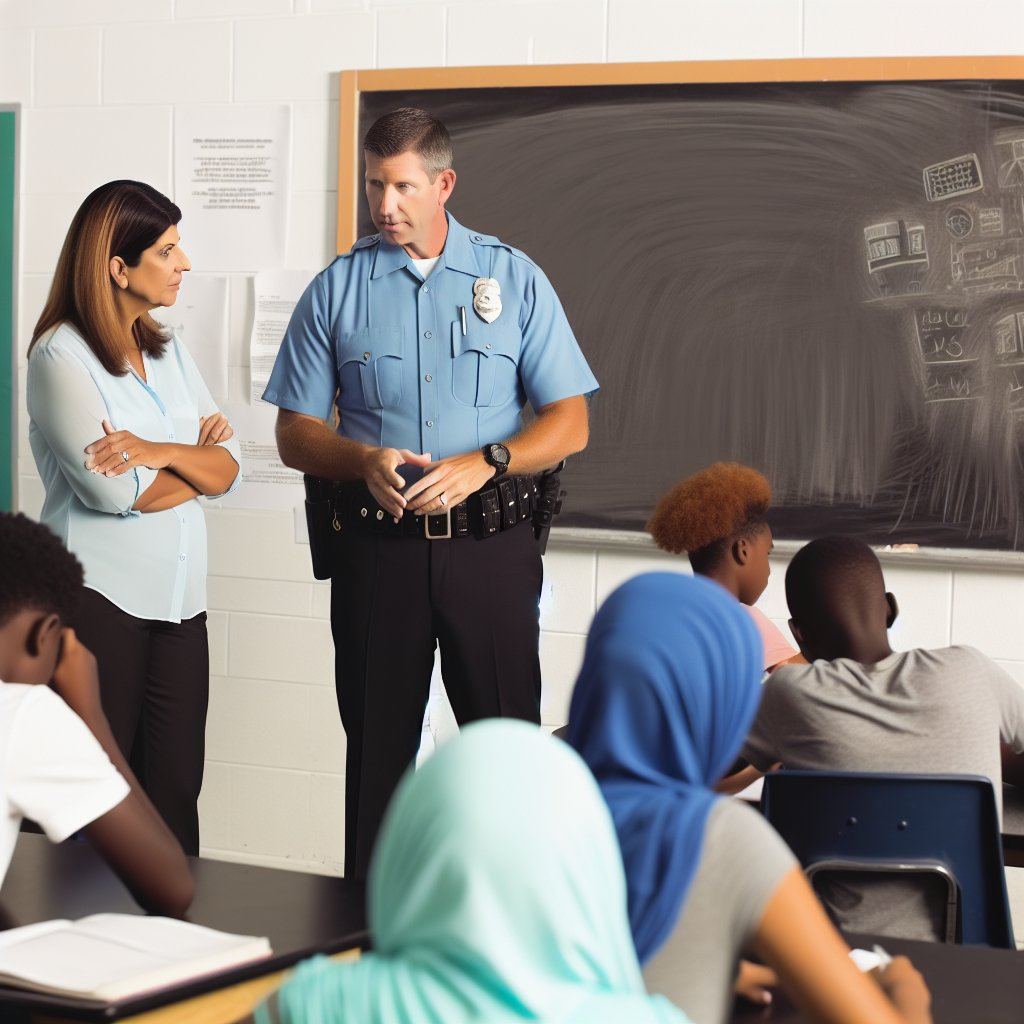Introduction:
School resource officers (SROs) play a vital role in ensuring the safety and security of educational institutions.
Collaboration between SROs and school staff is crucial for creating a safe and supportive learning environment.
By working together, strong partnerships can be formed to address safety concerns effectively.
Establishing communication protocols:
Discuss the importance of open lines of communication between SROs and school staff.
Highlight the need for regular meetings and sharing of information.
Provide examples of effective communication strategies.
The Importance of Open Communication:
Maintaining open lines of communication between School Resource Officers (SROs) and school staff is vital for ensuring the safety and security of students and staff members.
This collaboration allows for the sharing of information and quick responses to potential threats or incidents.
SROs can provide valuable insights and expertise on security and crisis management, while school staff can offer knowledge on student behavior and school dynamics.
When both parties communicate effectively, they can work together to address issues proactively and prevent potentially dangerous situations.
Regular Meetings and Information Sharing:
Regular meetings between SROs and school staff are essential for building trust and fostering a collaborative environment.
These meetings provide an opportunity to discuss any concerns, share updates on security protocols, and address any emerging issues.
During these meetings, it is important to ensure that both parties have a platform to voice their opinions and share information.
This open dialogue allows for a better understanding of each other’s roles and responsibilities, leading to effective collaboration in ensuring school safety.
Effective Communication Strategies:
- Utilize a secure communication platform or system to share sensitive information quickly and efficiently.
- Establish clear protocols for reporting incidents or suspicious activities to ensure a swift response.
- Conduct regular training sessions on effective communication techniques and protocols for both SROs and school staff.
- Encourage an open-door policy where staff and SROs feel comfortable approaching each other with concerns or information.
- Develop a communication plan for emergency situations that outlines roles, responsibilities, and communication channels.
By implementing these strategies, SROs and school staff can strengthen their partnership and work together effectively to create a safe and secure learning environment for students.
Promoting a positive school environment:
- Collaboration between SROs and staff can create a sense of security.
- Working together fosters a welcoming school culture for all.
- Positive relationships between SROs and staff impact students’ perceptions.
When school resource officers (SROs) and staff collaborate effectively, they can significantly contribute to promoting a positive school environment.
By working together, they can create a safe and welcoming atmosphere that is conducive to learning and personal growth.
Here are some ways in which collaboration between SROs and staff can help achieve this:
Explore ways in which collaboration between SROs and staff can contribute to a safe and welcoming school culture:
- Regular communication and sharing of information between SROs and staff.
- Training sessions on emergency preparedness and response.
- Collaboration on school safety and security protocols.
When SROs and staff collaborate on these aspects, it helps create a culture of safety and support within the school community.
Students, teachers, and parents feel reassured knowing that there is a strong partnership in place to address any potential safety concerns.
Transform Your Career Today
Unlock a personalized career strategy that drives real results. Get tailored advice and a roadmap designed just for you.
Start NowDiscuss the impact of positive relationships on students’ attitudes towards law enforcement:
- Building trust and rapport between SROs and students.
- Engaging in proactive outreach and mentoring programs.
- Participating in school events and activities to interact with students.
When students have positive interactions with SROs and see them as approachable and supportive figures, it helps foster a sense of trust and respect towards law enforcement.
This, in turn, can improve students’ attitudes towards authority figures and law enforcement agencies.
Provide tips for fostering a sense of community within the school:
- Encourage open communication and collaboration among all stakeholders.
- Organize community-building events and activities.
- Promote inclusivity and diversity within the school environment.
Creating a strong sense of community within the school involves bringing together students, staff, SROs, and parents in a collaborative and supportive environment.
By fostering connections and building relationships, schools can promote a culture of unity and cooperation that benefits everyone involved.
Collaboration between school resource officers and staff plays a vital role in promoting a positive school environment.
By working together, they can create a safe, welcoming, and inclusive culture that supports the well-being and success of all members of the school community.
Find Out More: TSA Officer Career Path: Opportunities for Advancement
Safeguarding the physical and emotional well-being of students
Collaboration between School Resource Officers (SROs) and staff is essential.
By working together, they can create a safer environment for students.
- Collaboration between SROs and staff can identify and address potential safety concerns.
- SROs play a vital role in providing support to students experiencing emotional distress.
- Creating a safe space for students to seek help and guidance is crucial.
Identifying and addressing potential safety concerns: SROs are trained to recognize signs of trouble.
They can work with school staff to address any safety issues.
This collaboration ensures that students are protected from harm.
Timely interventions are made when necessary.
Providing support to students experiencing emotional distress: SROs are often the first point of contact for students in crisis.
By working closely with school staff, they can provide emotional support.
They connect students with the help they need.
This collaboration can be instrumental in helping students navigate difficult situations.
Creating a safe space for students to seek help and guidance: When SROs and staff collaborate effectively, they create a supportive environment.
Students feel comfortable seeking help.
By fostering open communication and trust, they can ensure that students receive assistance.
Transform Your Career Today
Unlock a personalized career strategy that drives real results. Get tailored advice and a roadmap designed just for you.
Start NowThis safe space encourages students to speak up about any concerns.
It enables them to access support services when needed.
Collaboration is Key to Student Support
Collaboration between School Resource Officers and staff is crucial in safeguarding the well-being of students.
By working together, they can identify and address safety concerns.
They provide support to students in crisis.
Additionally, they create a safe space for students to seek guidance and assistance.
This collaboration ensures that students are safe, supported, and empowered to thrive in their academic environment.
Learn More: Emergency Management Director: Developing Leadership Skills
Addressing disciplinary issues:
Collaboration between School Resource Officers (SROs) and staff is crucial when addressing disciplinary issues in schools.
By working together, SROs and staff can ensure a comprehensive approach that addresses the root cause of student behavior.
One of the key benefits of a collaborative approach is the ability to tailor interventions to meet the unique needs of each student.
- For example, in a case where a student is experiencing trauma, the team can implement trauma-informed practices to provide support.
- Another example is when a student is struggling with mental health issues, the team can connect them with appropriate resources and services.
When SROs and staff work together, they can create a positive and supportive environment that fosters student well-being and success.
Successful interventions involving SROs and staff:
There are numerous examples of successful interventions where SROs and staff have worked together to address disciplinary issues effectively.
- In one instance, a student facing substance abuse issues was connected with a counselor and support services through the collaborative efforts of SROs and staff.
- In another case, restorative justice practices were used to resolve a conflict between students, leading to a peaceful resolution without further escalation.
These examples highlight the power of collaboration in addressing disciplinary issues and promoting a positive school climate.
Importance of restorative practices and de-escalation techniques:
Restorative practices focus on repairing harm caused by misconduct and rebuilding relationships within the school community.
When SROs and staff embrace restorative practices, they emphasize accountability, empathy, and solutions that promote growth and learning.
De-escalation techniques are vital in diffusing potentially volatile situations and preventing unnecessary use of force.
- By utilizing de-escalation techniques, SROs and staff can effectively manage challenging behaviors and promote a calm and safe learning environment.
- Training in de-escalation strategies equips the team to respond to conflicts with empathy and understanding, reducing the likelihood of negative outcomes.
Overall, the collaborative efforts of SROs and staff, combined with restorative practices and de-escalation techniques, play a crucial role in creating a positive school culture and supporting student success.
You Might Also Like: Parole Officer: Fieldwork vs. Office Work

Training and Professional Development:
- Emphasize the importance of ongoing training for both SROs and school staff.
- Discuss the benefits of cross-training opportunities to improve collaboration and understanding between the two groups.
- Provide resources for professional development in the field of school safety and security.
Training and professional development are essential components in fostering effective collaboration between School Resource Officers (SROs) and school staff.
Transform Your Career Today
Unlock a personalized career strategy that drives real results. Get tailored advice and a roadmap designed just for you.
Start NowBy investing in ongoing training, both groups can enhance their skills, knowledge, and understanding of each other’s roles and responsibilities.
For SROs, continuous training allows them to stay updated on the latest safety protocols, crisis intervention techniques, and legal requirements in schools.
This ensures that they are well-equipped to handle various emergencies and situations that may arise on school grounds.
Similarly, school staff can benefit from regular professional development opportunities that focus on topics such as de-escalation strategies, conflict resolution, and communication skills.
By enhancing their abilities in these areas, staff members can effectively support SROs in maintaining a safe and secure learning environment for students.
Benefits of Cross-Training Opportunities:
One effective way to improve collaboration between SROs and school staff is through cross-training opportunities.
By participating in joint training sessions, both groups can develop a deeper appreciation for each other’s roles and responsibilities, leading to enhanced communication and teamwork.
For example, SROs can benefit from learning more about the daily challenges and routines of school staff, such as classroom management techniques and student behavior interventions.
This knowledge can help SROs tailor their approach to better support staff members in addressing safety concerns and promoting positive student outcomes.
On the other hand, school staff can gain valuable insights into the roles and responsibilities of SROs by participating in training sessions focused on law enforcement protocols, emergency response procedures, and youth engagement strategies.
By understanding the challenges faced by SROs, school staff can collaborate more effectively with them to ensure a coordinated and cohesive approach to school safety.
Resources for Professional Development:
There are numerous resources available to support the professional development of both SROs and school staff in the field of school safety and security.
Organizations such as the National Association of School Resource Officers (NASRO) offer training programs, conferences, and resources specifically designed for SROs working in educational settings.
Additionally, schools can partner with local law enforcement agencies, community organizations, and professional associations to access a wide range of training opportunities on topics such as emergency preparedness, threat assessment, and crisis management.
By leveraging these resources, SROs and school staff can enhance their skills and knowledge to effectively collaborate in creating a safe and supportive school environment.
Uncover the Details: Women in State Trooper Roles: Breaking Barriers
Promoting Equity and Inclusivity
Creating an inclusive and equitable school environment is a shared responsibility between school resource officers (SROs) and staff.
Both play crucial roles in ensuring that all students feel safe, respected, and valued.
SROs can contribute to inclusivity by building positive relationships with students, particularly those from marginalized communities.
They can serve as mentors, advocates, and role models, showing all students that they are supported and cared for.
Transform Your Career Today
Unlock a personalized career strategy that drives real results. Get tailored advice and a roadmap designed just for you.
Start NowStaff members, on the other hand, can promote equity by recognizing and addressing their own biases.
Professional development opportunities focused on cultural competence and diversity training can help staff members cultivate a deeper understanding of different backgrounds and perspectives.
One strategy for addressing bias and promoting cultural sensitivity within the school community is to implement implicit bias training for all staff members.
This type of training can help individuals recognize and challenge their unconscious assumptions and stereotypes, ultimately fostering a more inclusive school environment.
It is vital to highlight the importance of promoting diversity and inclusion in all aspects of school governance.
This includes ensuring that policies, procedures, and decision-making processes are equitable and inclusive, reflecting the diverse needs and experiences of all students and staff.
Creating a diverse and inclusive school environment not only benefits individual students but also contributes to a more positive and supportive school culture overall.
When students feel acknowledged, respected, and valued, they are more likely to engage in learning and thrive academically and socially.
By working collaboratively, SROs and staff can foster a school community that celebrates diversity, promotes equity, and embraces inclusivity.
Together, they can create a learning environment where every student feels empowered to succeed and reach their full potential.
- Explore the role of SROs and staff in creating an inclusive and equitable school environment.
- Discuss strategies for addressing bias and promoting cultural sensitivity within the school community.
- Highlight the importance of promoting diversity and inclusion in all aspects of school governance.
Collaboration for a Safe Learning Environment
Collaboration between SROs and school staff is crucial for a safe and supportive learning environment.
Building strong partnerships and fostering community within schools should be a continued effort.
Readers are urged to prioritize collaboration and communication in their own school environments.




